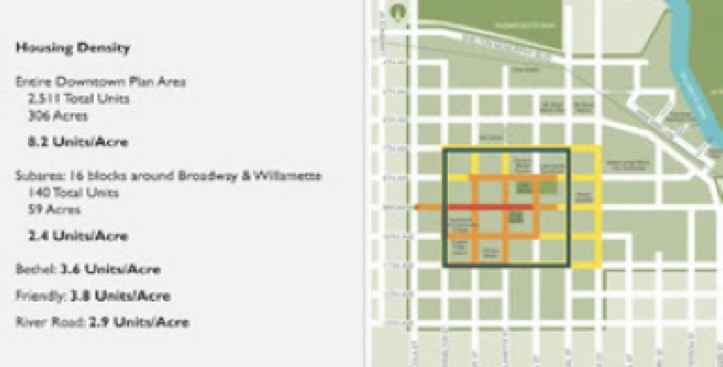THOUGHTFUL CONSIDERATIONS
Multiple online pieces regarding the future of the downtowns of U.S. cities piqued my interest this past week. The thread common to all is whether we should attribute the weakening of the nation’s most important urban centers to the persistence of work-from-home practices, the concomitant increases in office and storefront vacancies, and an attendant decline in property tax revenues. Despite their focus upon much larger cities (among them New York, San Francisco, Portland, and Seattle) these articles offered considerable food for thought here in Eugene.
One of the articles, by architecture critic Aaron Betsky for ARCHITECTUREmagazine, questions whether empty downtowns are here to stay. He goes on to argue that rather than worrying about how to reanimate the corpse of the central city, we should accept the realities of the American landscape—the downtowns as well as the suburbs. In promoting his thesis, Betsky cites another article by New York Times opinion writer Thomas Edsall. Edsall’s provocative supposition is that the downtowns of major cities are facing an “urban doom loop” because of now-entrenched WFH habits and office spaces not operating at full capacity. A resultant and accelerating disinvestment in those areas exacerbates the downward spiral.
The fact of the matter is that downtown Eugene’s woes are far from unique. As countless sources report, shuttered storefronts, an absence of people, sparsely populated offices, hobbled restaurants, and concerns about public safety are common across the country.(1) City officials work with local business leaders in a search for solutions, but many of the ideas they pose fail to yield appreciable gains. The emptier downtowns reflect broader economic and demographic changes that were in play before the pandemic accelerated the trend of remote work and e-commerce. That said, the fate of each city’s downtown area is influenced by a unique combination of local factors.
I reported last week on recent developments here in Eugene, two of which have implications of consequence for our downtown. For the sake of this blog entry, assume that negotiations between the City and the Eugene Water and Electric Board for the purchase of the former EWEB headquarters and its conversion to become the new city hall will be fruitful. Also assume the City of Eugene will amend the Skinner Butte Height Limitation Area, thereby allowing the Obie Companies to build taller on the parcels they own. Additionally, factor in the Riverfront Development project. Absent a magic bullet, you can picture that either a further deterioration or transformation of the historical urban core (the area roughly defined by the current boundaries of the Downtown Urban Renewal District) has been set in motion. Together, these actions may irretrievably shift Eugene’s de facto core northward toward the river and deal a mortal blow to downtown’s critical mass and stature as the city's center of gravity.
But what if we accept this fate for downtown Eugene and instead reframe its future differently? What if we abandon efforts to resurrect downtown founded upon a flawed vision of what it should and is destined to be? What if we accept reality and stop worrying about reanimating the corpse as Aaron Betsky suggests we should? Conversely, does the post-COVID condition present a once-in-a-generation chance to revive our downtown? Is downtown Eugene’s fate further deterioration or transformation?
Rather than attempt to fully resurrect our downtown core along the lines of what it once was—a center for commerce, government, and culture—I believe we should emphasize the development of housing of all types at various levels, both market-rate and subsidized, at mid-to-high levels of density. With such a focus, housing would supplant investments in commercial office or retail space, which have not materialized and increasingly do not appear likely to in the foreseeable future. Downtown would never be what it once was, but it could become a vibrant neighborhood of a different, evolved type. If housing becomes a dominant building form, supporting services and vibrant streets will follow.
According to City staff, at only 8.2 units per acre, Eugene’s downtown current housing density is discouragingly low relative to its peers around the country. This drops even lower to only 2.4 units per acre in the immediate, 16-block vicinity of the Broadway and Willamette Street intersection (within the green square in the diagram above), perhaps downtown’s most troubled area. For comparison, this density is exceeded by the areas of the Bethel, Friendly, and River Road neighborhoods zoned R-1. Increasing the population housed downtown can help lessen crime (more eyes on the street), vagrancy (if housing options for the most disenfranchised are developed), and pollution (fewer trips by car).
Critically, the City of Eugene’s Downtown Urban Renewal District has reached a crossroads. The Downtown Renewal Plan does not prescribe a specific sunset date for the District, but rather the District’s division of tax will stop when the total maximum indebtedness (i.e. the spending limit) for the District has been issued and paid. Currently, the Downtown Urban Renewal District is expected to have sufficient tax revenues to reach its spending limit this coming December, meaning it would cease the collection of tax increment funds at that time and effectively expire.
To help guide the future of the city core, staff compiled a draft list of downtown priorities and projects organized into six categories: Housing, Public Safety, Social Services, Community Activity & Development, Public Spaces & Mobility, and Events & Culture. They compiled the possible projects following input from the community, their own work, and existing plans. An interdepartmental team is evaluating criteria such as cost, potential funding sources, feasibility, effectiveness, and alignment with City policies. The Urban Renewal Agency (comprised of the members of the Eugene City Council) discussed the list of priorities and projects this past Wednesday in a work session. The Agency voted at the conclusion of the session to have staff proceed with drafting a proposal to amend the Downtown Urban Renewal Plan.
Moving forward, a key decision for the Urban Renewal Agency to make is whether to expand the Downtown Urban Renewal Plan’s financial capacity and add additional projects. If they choose to do so, a measure may appear as soon as on the November 2023 ballot. If passed, taxes collected within the District would continue to be used on eligible capital projects.
Assuming voters approve continuation of the collection of taxes for urban renewal purposes in the Downtown District, I first and foremost believe the additional funds should be applied toward acquiring properties for offer at reduced cost to developers to build housing or to otherwise help make housing projects pencil out. Assisting social service providers and increasing public safety and cleanliness will also be important.
The relocation of City Hall to the former EWEB headquarters building, the growth of the Obie Companies Market District, and the Riverfront Development mark a tipping point for the future of Eugene’s downtown. City Hall will not occupy the Town Square on the historic Park Blocks. The retail segment south of 7th Avenue will further fade. Focusing upon the creation of new housing and greatly increasing the downtown population will move our urban center away from what it once was and what up until recently we hoped it could again become. This shift will take time but carries with it the possibility for a positive transformation. What downtown Eugene means to everyone will be different. It can become the new home and neighborhood for many people, in addition to being a place to work, access government services, and share in community.
(1) These reports may be overstated and politically motivated in some instances, purposely suggesting a more dire situation than exists. Nevertheless, perception is reality, and a negative perception can amplify the effect by having an influence on the process that gave rise to it—a positive feedback mechanism that contributes to the “urban doom loop.”







